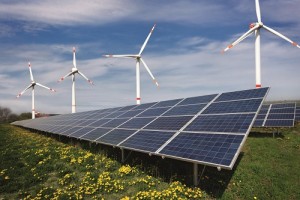How much mined material will we need to build a 100-per-cent renewable world? Danny Chivers works it out.
The problem with wind turbines, solar panels, ground-source heat pumps and electric cars is that they’re all made of stuff. When people like me make grand announcements (and interactive infographics) explaining how we don’t need to burn fossil fuels because fairly shared renewable energy could give everyone on the planet a good quality of life, this is the bit of the story that often gets missed out. We can’t just pull all this sustainable technology out of the air – it’s made from annoyingly solid materials that need to come from somewhere.
So how much material would we need to transition to a 100-per-cent renewable world? For my new NoNonsense book, Renewable Energy: cleaner, fairer ways to power the planet, I realized I needed to find an answer to this question. It’s irresponsible to advocate a renewably powered planet without being open and honest about what the real-world impacts of such a transition might be.
In this online article, I make a stab at coming up with an answer – but first I need to lay down a quick proviso. All the numbers in this piece are rough, ball-park figures, that simply aim to give us a sense of the scale of materials we’re talking about. Nothing in this piece is meant to be a vision of the ‘correct’ way to build a 100-per-cent renewably powered world. There is no single path to a clean-energy future; we need a democratic energy transition led by a mass global movement creating solutions to suit people’s specific communities and situations, not some kind of top-down model imposed from above. This article just presents one scenario, with the sole aim of helping us to understand the challenge.
– See more at: http://newint.org/blog/2015/08/15/material-requirements/#sthash.FQbbzNu7.dpuf


![28.09.15-yes-to-renewables-590x393.jpg [Related Image]](http://newint.org/blog/2015/09/28/28.09.15-yes-to-renewables-590x393.jpg)










